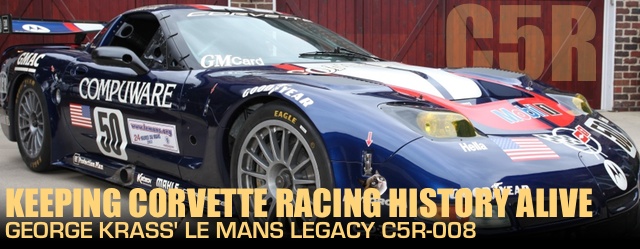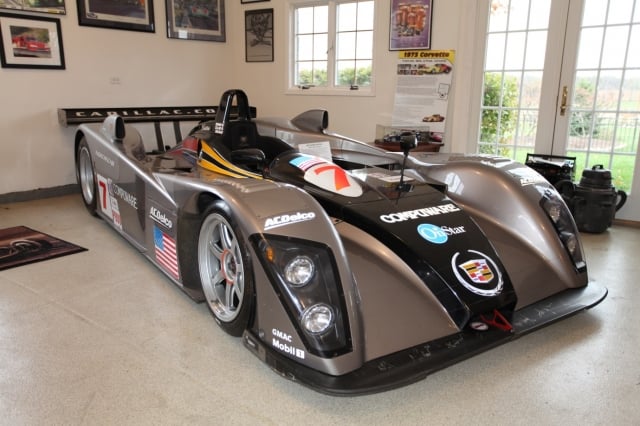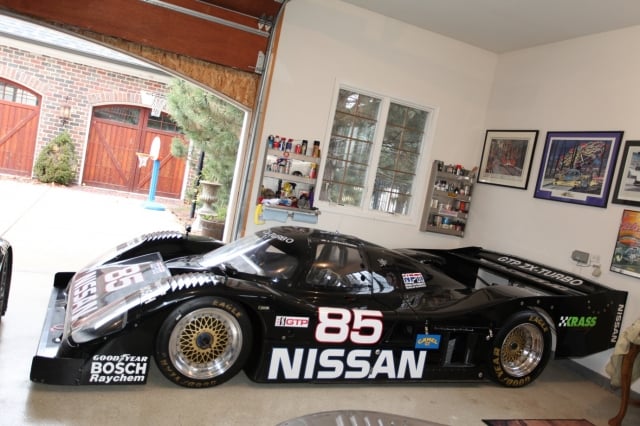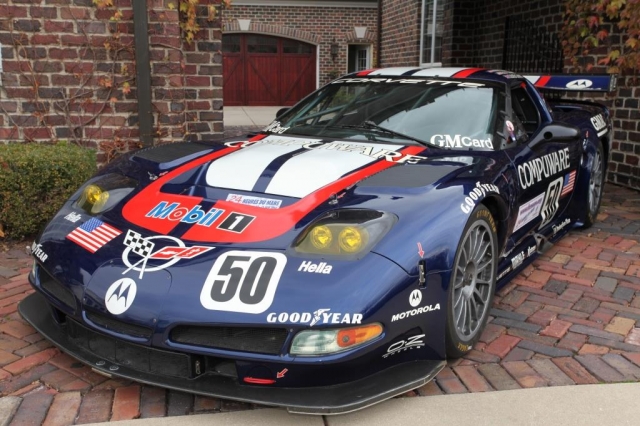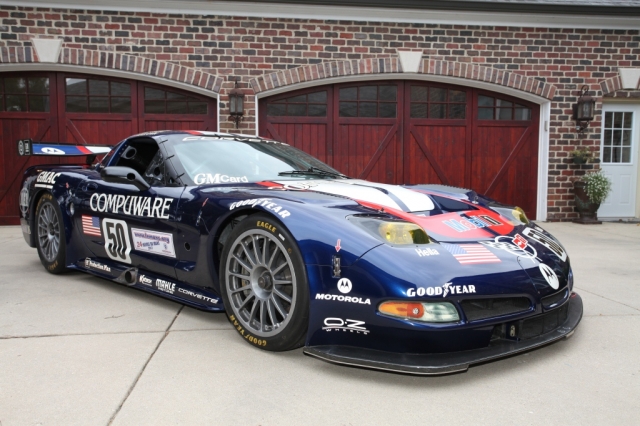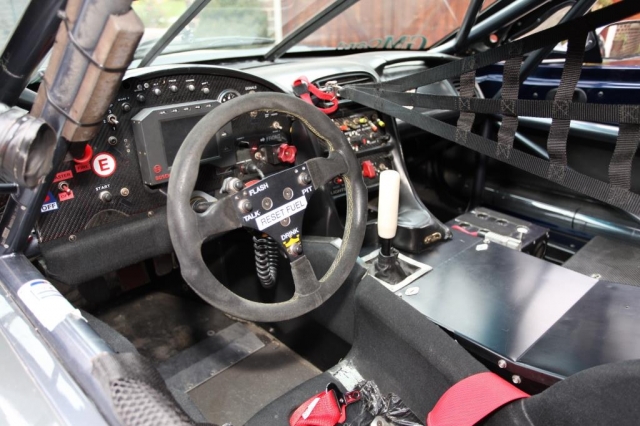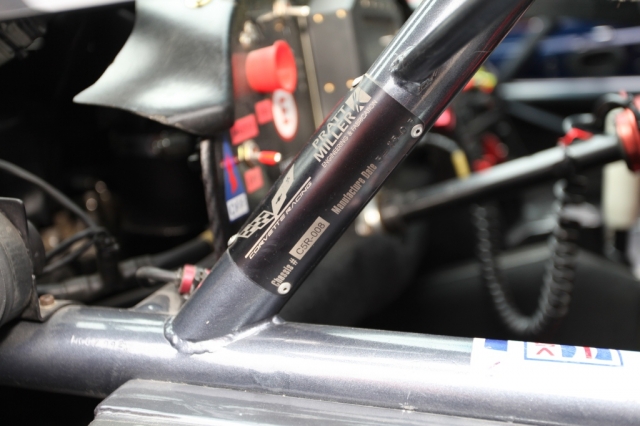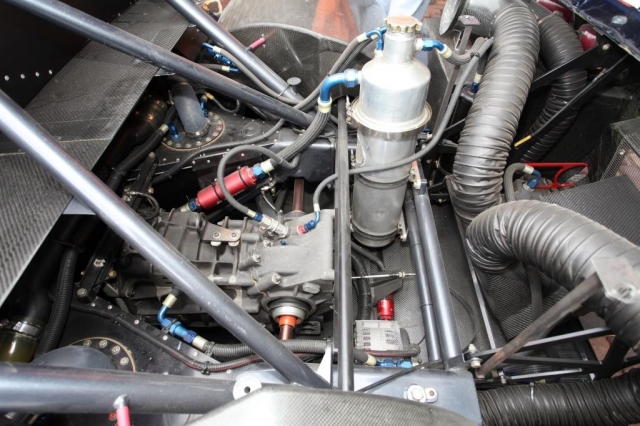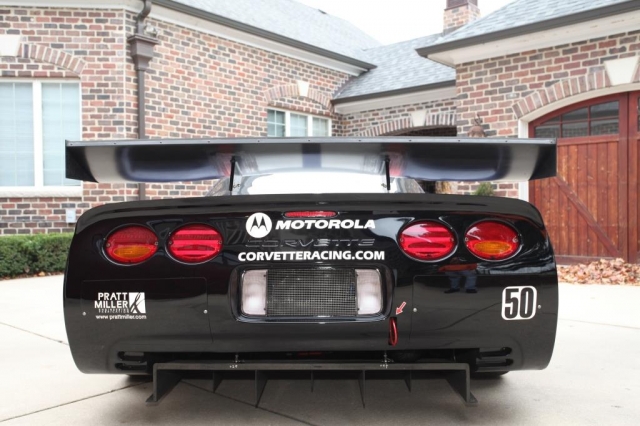Sometimes it’s interesting how fate brings people together. George Krass [2] Facebooked me about a year ago after buying a copy of my book “Corvette Racing – The GT1 Years” available from the National Corvette Museum Shop [3]. We talked via Facebook and discovered we live about an hour away from each other, so we arranged to meet up one Saturday. George owns a relatively modest house with lots of garaging – he’s a man after my own heart. In the main garage he has a Nissan Group C car, a Cadillac LMP1 car, and the reason I was visiting, one of the Corvette chassis C5R-008, the #50 car from Le Mans in 2003.
Not what you'd normally expect to see in a residential garage...
Of course, we got to talking about the car, and how it came to be in his possession. Here’s what he had to say…
Corvette Online: So how did you end up getting into Corvettes?
This sucks! I don’t want to be on this side of the camera, I want to be on the other side! I want to race! – George Krass
George Krass: “I was 19 years old, and I ended up selling my Nova to buy a Corvette to drive my girlfriend around in, who ended up being my first wife. I bought a ’71 Corvette in the ugliest color in the world – Warbonnet Yellow when I bought it. It was silver from the factory but I restored back to the original color. I went to school down at Illinois State and that’s where I met David Burrows, the organizer of Bloomington Gold [6]. [Krass was a Bloomington Gold 70-72 chassis judge] Then I thought, ‘I gotta have a mid-year,’ so I bought a ‘66, 327/350 horsepower Milano Maroon Coupe.”
“My major in college was graphic design, and I got a job with Auto Meter [7]. I was Art Director and Advertising Manager, so I had the perfect dream job. I was paid to go to the races, take photos, come back, and put them in the catalog. Going to the races caused a huge problem, though – I wanted to race! ‘This sucks,’ I said to myself. ‘I don’t want to be on this side of the camera, I want to be on the other side! I want to race!’ So I sold the mid-year and bought a Suburban, the $7,250 Bill Morrison ’73 Corvette, and a trailer. I went out to Blackhawk [8], joined the Midwest Council [9], and wrecked it first time out in drivers school! I haven’t had an accident since – that was 1994.”
CO: Why did you buy the C5R?
GK: “Any car I buy, I intend to race – do I have the time to? No, I used to have all the time in the world to race, so I ran in GT1 SCCA in a vintage Corvette, then I bought a Riley & Scott; I ended up buying two. Once I found out how much I really preferred the prototypes, that was when I started looking for more of the prototypes I like. Which is why I bought the Cadillac, and then I traded one of the Riley Mark IIIc’s [the other one which George still owns was at his workshop] towards the purchase of the Nissan. The Cadillac I definitely want to race. ‘When?’ is a better question.”
CO: If you like prototypes, why did you buy the Corvette?
GK: “I’m a Corvette guy at heart. I was a Corvette guy way before prototypes. My dad was into Corvettes, so since I was in seventh grade it was always Corvettes in our family. My first race car was a Corvette – I vintage raced that for years. I bought it as GT1 car in 1994 for $7,250, and turned it into a big fat Greenwood widebodied car with a 540 cubic inch all-aluminum Donovan Kinsler fuel-injected cross ram 900 horsepower motor. Ran it at Daytona, raced it that way for years, then wanted to go faster.”
“I had a Winston Cup car, ran that for a while, then I got the GT1 Trans Am Mustang. Raced that for years, then we decided to restore the Corvette back to the way it was. It was a 1977 Central Division National Champ that won the June Sprints [12] in ’77. It had good history. I knew the original owners and engine builders. So I restored it back to exactly the way it was when he raced it, but nicer – it was heavily over-restored.”
“Then it got accepted to run out at the Monterey Historics [13] in 2011. We took it out then and it ended up getting sold at RM Auctions [14]. A guy called Paul Knapfield from England bought it. Then I ended up selling the Mustang and I bought the C5R because it’s very similar to a GT1 or Trans Am car, and I decided that was the bodied car I wanted to race.”
CO: When you came to buy this particular chassis C5R-008, which was owned by Robert Patrella over in Ohio, how did you go about buying it?
GK: “I called one of the guys who worked at Robert’s shop who he had listed as a contact when he was trying to sell it, and when I talked to him and asked him the various questions, I think he was taken because I knew more about the car than he did, and Robert for that matter! They had some other people talking to them, but no one seemed real interested as it was when the economy had really tanked. Robert had 40 some cars in his collection, and of course he had two of the same car [Robert Patrella also has chassis C5R-009] and he decided he just had to get rid of one.”
“The funny thing is he wanted to keep the Earnhardt car that had been totalled and burnt to the ground [Dale Jr. destroyed the car in practice at Sonoma in 2004 [16]]. I wanted the car that finished second at Le Mans, and not the one that didn’t do as well. I couldn’t afford any of the Le Mans class-winning cars, as I would have had to sell my house, my wife, my children and everything else, so I figured the next best thing I could get was the second place Le Mans car – that is the car that I want.”
“So I went and talked to Robert, and I think once he met me and he saw how much I cared about the car, even though I was a lot younger than other people who were interested in the car, he kind of took a liking to me. I think he is about my dad’s age, so he sold me the car for what I could afford. Which was amazing, because he lost his shorts a little bit, but at any rate I was very lucky to get it.”
“I had looked around for a while, and there was another chassis, C5R-005, for sale out on the West Coast a few years ago. I called Dan Binks [17] because a friend of mine is friends with him and Dan said, ‘Okay George, that car is going to need this, this and this, so it would be a good car but you’re going to need to do this stuff to it.'”
“I ended up passing on that car, which at the time I was regretting very, very much, as I realized these aren’t going to come up for sale very often. Nobody else has one to sell, so the only one I could think of was Robert Patrella. I thought I’ve got to put the ‘full court press’ on, and that’s how I got this car. Chassis C5R-006 was for sale over in Belgium, and they were really giving it away (it was listed for sale for approximately $260,000), but it really needs a lot of stuff as I talked to Binks about that one too. That one had really been run through the wringer – it had been raced a lot. My car has only been raced by factory drivers and only eight times, I think. No one has driven it apart from those guys.”
“When I looked at the condition of it, it had been restored by Pratt & Miller – what more do I want? I’m not going to be able to find one in better condition. It’s got some of the fewest races on it, it’s got the Le Mans second place finish. Everybody wants #3 the (Daytona 2001 car driven by the Earnhardts) but that’s not going anywhere any time soon.”
“I’ll tell you a funny story. The sister #53 car that Robert Patrella owns has three yellow stripes on the passenger side mirror because Johnny O’Connell didn’t want to drive a car that wasn’t yellow. So when they raced it at Le Mans, the team put three yellow masking tape stripes on the mirror, and when Pratt & Miller restored the car they put the masking tape stripes back on the car.”
CO: Tell me about the gearbox on this car…
GK: “Up to 2002 they had a Hewland non-sequential box in the cars. In this and the sister 009 chassis car, they ran this sequential Hewland gearbox, and they went to the X-Trac sequential gearbox in chassis 010 and 011 and that fixed the reliability problem [at Le Mans in 2003, a 45 minute stop to swap gearboxes cost the win, with Ferrari coming in 43 minutes ahead.]”
CO: So do you have a spare, in case yours develops a problem? And do you have other spares for when you take this car to the track?
GK: “I know that Dave the parts guy at Pratt & Miller says they have one of these boxes, and I’m going to be the only guy that needs one, as Robert is never going to race his car. I need Pratt & Miller to check the map on the motor as I am not sure it’s right, as they gave the car to a collector. It didn’t have the right shocks on it, so to put the right shocks and springs – that cost $6,000. Then I needed a set of brake pads, so I bought a set of used pads for $1,600. I didn’t know what spring setup was on it either, so I said, ‘Give me a set for Sebring and Road America.’ Road America’s are a little stiffer, and right now I’ve put the Sebring ones in, which are a little softer.”
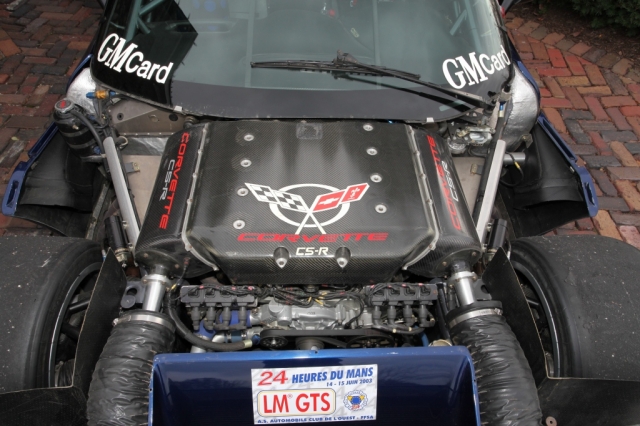 [20]CO: So when it comes to starting it up and running it, what’s the procedure?
[20]CO: So when it comes to starting it up and running it, what’s the procedure?
GK: “In this car, Katech [21] built the motor loose, so you don’t have to pre-heat it. They did that for Robert Patrella as he didn’t want the hassles of starting. We crank it until it gets oil pressure, then we turn on the fuel and ignition and just start it up. It’s one of the original C5R motors, and when Pratt & Miller restored the car Katech built the engine with bigger clearances.”
Many thanks to George Krass for letting us see his fabulous cars and for providing me with a most entertaining afternoon talking about Corvette race cars, our shared passion.
